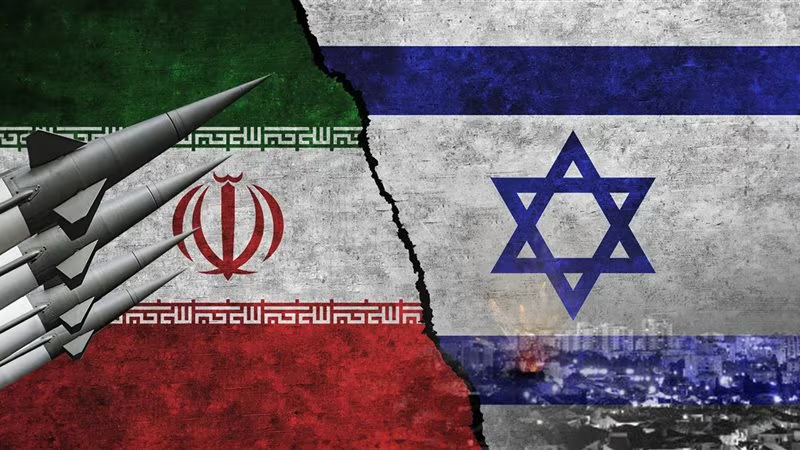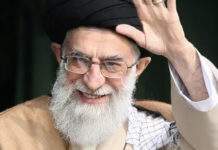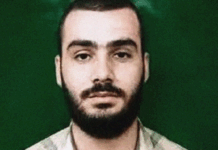Od początku wojny między Izraelem a frakcjami palestyńskimi w Gazie Izrael stoi również w obliczu ataków z południowego Libanu. Oprócz ataków Hezbollahu (którego obecność w południowym Libanie narusza uchwałę Rady Bezpieczeństwa ONZ nr 1701 zakazującą obecności uzbrojonych bojówek na południe od rzeki Litani) i innych organizacji libańskich [1] , frakcje palestyńskie, takie jak Hamas i Palestyński Islamski Dżihad (PIJ) również są aktywne. Ich ataki, które obejmują próby infiltracji terytorium Izraela i odpalanie rakiet dalekiego zasięgu, wskazują na istnienie palestyńskiej infrastruktury wojskowej w Libanie.
Hamas i PIJ zasadniczo utworzyły w kraju oddziały swoich skrzydeł wojskowych i zbudowały infrastrukturę wojskową zarówno wewnątrz, jak i na zewnątrz obozów dla uchodźców palestyńskich w Libanie. Tym samym zamienili południowy Liban lub cały kraj w kolejną arenę palestyńskich działań wojskowych, prowadzonych nie tylko przez bojówkarzy palestyńskich i libańskich, ale także bojówkarzy z innych krajów. W rzeczywistości Hamas ogłosił niedawno utworzenie oficjalnego nowego oddziału w Libanie, Straży Przedniej organizacji Potop Al-Aksa. Na krótko przed atakiem z 7 października PIJ również ogłosił utworzenie oddziału wojskowego w Libanie.
Działalność palestyńskich i libańskich frakcji zbrojnych w południowym Libanie, obszarze kontrolowanym przez Hezbollah, najwyraźniej odbywa się w koordynacji z tą organizacją, a być może nawet pod jej przewodnictwem, w sposób służący jej interesom w ramach strategii „jedności frontów”, któremu przewodzi wraz z Iranem. Co więcej, wydaje się, że frakcje te działają jako pełnomocnicy Hezbollahu, gdy ten chce ograniczyć zakres własnej działalności przeciwko Izraelowi.
Jeżeli ta zbrojna akcja palestyńska ma miejsce bez wiedzy władz libańskich, stanowi to rażące naruszenie suwerenności państwa libańskiego. A jeśli władze libańskie są świadome tej działalności, oznacza to, że Liban świadomie pozwala na przekształcenie się w centrum działalności terrorystycznej.
Rozwój sytuacji potwierdza obawy wyrażane przez lata przez wielu Libańczyków, że broń znajdująca się w obozach dla uchodźców palestyńskich w Libanie nie pozostanie ograniczona do obozów, ale ponownie przekształci kraj w bazę dla zbrojnych działań palestyńskich przeciwko Izraelowi, tak jak miało to miejsce w latach 70. i 80. XX w. – sytuacja, która ostatecznie doprowadziła do izraelskiej inwazji na Liban w 1982 r. Ostatnio w Libanie toczy się otwarta krytyka palestyńskich działań wojskowych w tym kraju oraz przeciwko zgodzie państwa libańskiego i jego sił zbrojnych na tę działalność.
Ataki rakietowe i infiltracje sił Hamasu i PIJ w Libanie
Zaledwie trzy dni po wybuchu wojny w Gazie frakcje palestyńskie zaczęły przypisywać sobie odpowiedzialność za działania militarne przeciwko Izraelowi z południowego Libanu, a libański oddział Brygad Izz Al-Din Al-Kassam, wojskowego skrzydła Hamasu, przyjął odpowiedzialność za większość ataków. Większość ataków polegała na wystrzeleniu dziesiątek rakiet w kierunku skupisk ludności w północnym Izraelu, sięgających aż do Hajfy, co wskazuje na wielkość i jakość arsenału, jakim dysponuje Hamas w Libanie.
W październiku 2023 r. – lutym 2024 r. Brygady Al-Kassam przeprowadziły następujące ataki rakietowe na Izrael z południowego Libanu:
10 października 2023: atak rakietowy na Galileę Zachodnią; [2]
15 października 2023 r.: ostrzał 15 rakiet wystrzelony w kierunku miast Szlomi i Naharija w zachodniej Galilei; [3]
19 października 2023: ostrzał 30 rakiet, większość z nich wycelowana w Szlomi i Naharija; [4]
29 października: ostrzał 16 rakiet na Naharija; [5]
2 listopada 2023 r.: ostrzał 12 rakiet na miasto Kirjat Szmona i jego okolice; [6]
6 listopada 2023: ostrzał 16 rakiet wycelowany w Nahariję i „południową Hajfę”; [7]
12 listopada 2023: rakiety wystrzelone w południową Hajfę, Szlomi i Nahariję; [8]
10 grudnia 2023: rakiety na cele wojskowe w Galilei Zachodniej; [9]
25 grudnia 2023: wystrzelenie rakiet w stronę bazy wojskowej Liman w Galilei Zachodniej; [10]
17 stycznia 2024: ostrzał 20 rakiet na bazę Liman; [11]
28 lutego 2024 r.: ostrzał 40 rakiet Grad wycelowanych w kilka celów w rejonie Beit Hillel i w Kirjat Szmona. [12]
Podejmowano także próby infiltracji terytorium Izraela z Libanu. 15 października Brygady Al-Kassam poinformowały, że dwa dni wcześniej grupa agentów Nuchby (sił specjalnych) zbliżyła się do granicy libańsko-izraelskiej, starła się z żołnierzami IDF i zdołała wycofać się bez szwanku. 14 października grupie bojówkarzy udało się przełamać płot graniczny przy użyciu materiałów wybuchowych i zaatakować pozycję armii izraelskiej w pobliżu Margaliot. Według doniesień trzech członków grupy zginęło w wyniku ostrzału z helikoptera. Dwóch z nich pochodziło z obozu dla uchodźców Ajn Al-Hilweh na południowy wschód od Sydonu, a jeden z obozu Wadi Al-Zina niedaleko Bejrutu. Organizacja opublikowała nazwiska i zdjęcia zabitych członków. [13]
Ataki na Izrael z południowego Libanu oraz kaliber zaangażowanych w nie funkcjonariuszy obnażają zakres działalności wojskowej Hamasu w tym kraju. 22 listopada Hamas ujawnił, że jeden z jego agentów, Chalil Hamed Charraz, znany również jako Abu Chaled, z obozu dla uchodźców Al-Raszida niedaleko Tyru, zginął w izraelskim ataku na granicy libańsko-izraelskiej. Według oświadczenia był on „dowódcą” odpowiedzialnym za „rozszerzanie wsparcia i pomocy dla ruchu oporu w [Palestynie] i poza nią… i od dziesięcioleci był aktywny na wszystkich frontach dżihadu”. [14] Doniesienia źródeł libańskich twierdziły, że Charraz był dowódcą Al-Kassam w Libanie. Tego samego dnia Hamas poinformował o śmierci czterech innych agentów Al-Kassam, dwóch Turków i dwóch Libańczyków. Według doniesień prasy arabskiej i tureckiej zginęli oni wraz z Charrazem, co sugeruje, że byli to wyżsi rangą funkcjonariusze organizacji. [15] Fakt, że Hamas najwyraźniej werbuje zagranicznych bojowników, wskazuje na zakres jego swobody działania w południowym Libanie.
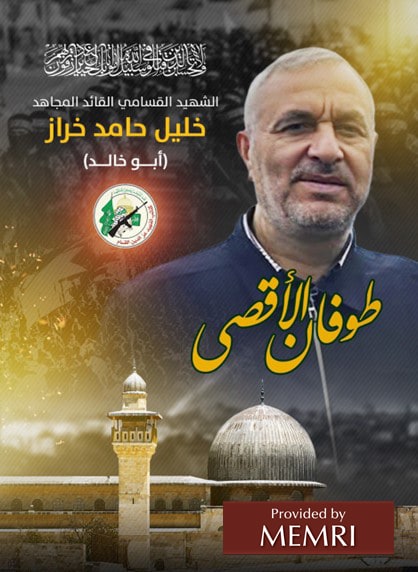
[Ciąg dalszy tekstu – opis działalności grup palestyńskich, współpracy z Hezbollahem i reakcji rządu libańskiego – nie jest spolszczony]
Hamas’ announcement of Kharraz’s death
On January 2, 2024, Saleh Al-Arouri, the deputy head of Hamas’ political bureau, was killed in Beirut in a strike attributed to Israel, along with two senior Al-Qassam fighters – Azzam Husni Al-Aqra, who was in charge of the movement’s military action abroad, and Samir Fandi, who was responsible for its military activity in South Lebanon[16]– as well as four other operatives. In a statement issued in response to their killing, Hamas said that the assassination was proof that „fighting and deterring [Israel] is a duty incumbent upon every member of our [Islamic] nation in every arena and on every front… Sheikh Salah and his brethren acted [to perform this duty] and mobilized all the nation’s forces to this end…”[17] On January 18, 2024 Hamas reported that another activist, from the Mieh Mieh camp near Sidon, had been killed in South Lebanon.[18]
The PIJ launches attacks on Israel from South Lebanon as well. On October 10, 2023 it announced that two of its fighters, Riad Muhammad Qiblawi from the Ayn Al-Hilweh camp and Hamza Hassan from the Al-Burj Al-Shamali camp near Tyre, had been killed after exchanging fire with IDF forces on the border.[19]
On October 22 the PIJ announced that four of its operatives, two from Syria and two from Lebanon, had been killed one day earlier during activity in „northern Palestine.” The announcement featured pictures of the four, three of them in PIJ uniform.[20]
On October 29 two PIJ fighters were killed in an exchange of fire with IDF forces after trying to infiltrate the border in the Hanita area,[21] and on December 7 the organization reported the death in South Lebanon of two operatives from the Khan Danoun camp near Damascus, Syria, who were members of the Syria-based Shahid Ali Al-Usoud Brigade.[22] On December 29 the PIJ again reported that two operatives – one from the Shahid Ali Al-Usoud Brigade and another from the Shahid Abu Hamza Al-Majdoub Brigade – had been killed „in the line of duty” on the Lebanon-Israel border,[23] and on February 12, 2024 it announced that two more members of the Shahid Ali Al-Usoud Brigade had fallen there too.[24] The death in South Lebanon of two additional fighters from this brigade was reported on February 24, 2024.[25]
Hamas’ And PIJ’s Activity In Lebanon Takes Place With Hizbullah’s Consent And In Coordination With It
As stated, this is the first time in 40 years that the Palestinian factions have claimed responsibility for ongoing offensive action against Israel from South Lebanon. In the 1970s such action by armed Palestinian factions, chief of them the PLO, led to a civil war in Lebanon and later to an extensive Israeli operation in the south of the country. In that period the Palestinian factions did as they pleased in Lebanon without coordinating with local elements. Today, although their action is not coordinated with the Lebanese state and armed forces, it is definitely directed and approved by the true boss in Lebanon, namely by Hizbullah.
Hamas officials state explicitly that they operate under Hizbullah’s sponsorship and in coordination with it. Hamas representative in Lebanon Ahmad Abd Al-Hadi clarified: „The operations of the Al-Qassam Brigades in South Lebanon confirm that the Palestinians in Lebanon are a key element in the campaign [against Israel]. These [operations] are carried out in coordination with our brethren in Hizbullah.”[26] Walid Al-Kilani, Hamas’ spokesman in Lebanon, made similar remarks, saying: „Our participation [in the fighting] in South Lebanon is meant to show solidarity [with Gaza], and it is sponsored by Hizbullah and carried out in coordination with it.”[27]
PIJ representatives in Lebanon stressed their right to operate in South Lebanon without the consent of the Lebanese government. PIJ official Imad Al-Rifa’i said: „The Lebanese state and armed forces are unable to confront Israel, for a variety of reasons… We appreciate Lebanon’s situation, but there is a people that is being slaughtered, and we cannot sit idly by… Our only way to prevent [Israel] from expelling [the Palestinians from Gaza] is through resistance. There are 450,000 Palestinians living in Lebanon, and they will not allow another Nakba to occur.”[28]
Another indication of the coordination between the Palestinian factions and Hizbullah is a report by the online daily Al-Rai Al-Yawm that Hamas’ Al-Qassam Brigades and Saraya Al-Quds, the military wing of the PIJ, had asked Hizbullah to grant them greater independence and freedom of action in fighting Israel from South Lebanon. They also asked Hizbullah to suffice with receiving advance notice of their operations and exempt them from seeking its specific approval for each action. In addition, they requested permission to recruit Palestinians residing in Lebanon to their ranks.[29]
Indications That Hamas Is Building Permanent Infrastructure For Operations From Lebanon
Hamas’ acknowledgement that it is using Lebanon as a base for military action against Israel is a strategic turning point in the policy of this organization, because for many years it stressed that its military activity was confined to the Palestinian territories and Israel. Cracks in this policy began to appear over the last decade, when targeted killings by Israel exposed Hamas combatants operating abroad. The most prominent of these operatives were Hamas’ drone engineer Muhammad Al-Zawi, killed in Tunisia in 2016, and rocket expert Fadi Al-Batsh, killed in Malaysia in 2018, both of whom were engaged in developing the movement’s military capabilities in the Palestinian territories.
In fact, Hamas announced its intention to start operating outside Palestine already in 2015. At a February 2 political rally in Gaza, Hamas political leader Mahmoud Al-Zahhar called on Lebanon and Syria to allow the formation of military cells subordinate to the Al-Qassam Brigades in the Palestinian refugee camps on their soil, which would take part in liberating Palestine.”[30] In 2018 Hamas leader Islma’il Haniya said, in response to the killing of the organization’s rocket expert Fadi Al-Batsh in Malaysia, that „the battle with Israel has moved outside the occupied lands.”[31]
The characteristics of Hamas’ activity from South Lebanon since the start of the current war indicate that this activity is not the result of hasty preparations made after the outbreak of the war, but of planning and preparation in advance that included efforts by Hamas to tighten its relations with Hizbullah and to deepen its influence in the Palestinian refugee camps in Lebanon, as well as unofficial military activity in Lebanon over the years, among other moves.
Hamas’ activity in Lebanon clearly requires the consent of Hizbullah, which controls South Lebanon and apparently the country as a whole. Therefore, after several years in which the relations between the two organizations cooled somewhat, due to Hamas’ support for the rebellion against the Syrian regime, which is an ally of Hizbullah and Iran, Hamas took pains to restore its relations with them. Hamas’ desire for rapprochement with Hizbullah accorded with the interests of this organization and of its patron Iran, which sought to tighten their grip on Hamas and thereby on the Palestinian arena as a whole, and to implement their strategy of „the unity of the fronts,” according to which an attack on any part of the resistance axis prompts an extensive response by all the components of this axis, in every arena.
The tighter cooperation between Hamas and Hizbullah was manifest in frequent meetings between the leaders of the two organizations and in visits by Hamas officials in Lebanon. Hamas leader Isma’il Haniya, for example, has made at least three visits to Lebanon since 2020, during which he met with Hizbullah Secretary-General Hassan Nasrallah and also made highly visible tours of the Palestinian refugee camps. Haniya’s visit sparked intense criticism from Hizbullah’s opponents in Lebanon, which expressed concern that the country would be dragged into a confrontation with Israel.[32]
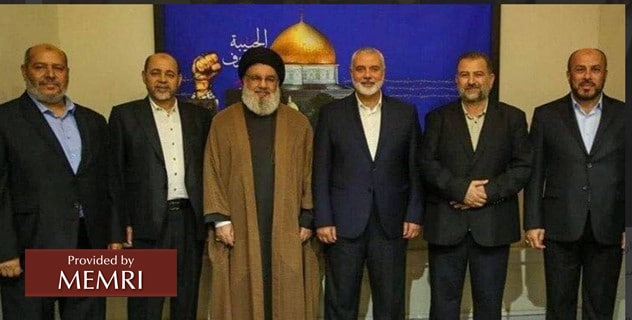 Meeting between Hassan Nasrallah and Hamas delegation headed by Isma’il Haniya in April 2023 (Image: Ar.irna.ir, April 7, 2023)
Meeting between Hassan Nasrallah and Hamas delegation headed by Isma’il Haniya in April 2023 (Image: Ar.irna.ir, April 7, 2023)
Hamas Tightens Its Grip On Palestinian Refugee Camps In Lebanon, At Fatah’s Expense
As part of establishing itself in Lebanon, Hamas has also tightened its grip on the Palestinian refugee camps there. According to an article in the Lebanese daily Al-Mudun, this process started already in the 1990s, but Hamas was initially careful to conceal its military presence there. Not so today. In an interview on Al-Jazeera in late 2023, Muhammad Ibrahim Madhoun, head of Hamas’ refugee department, addressed the importance ascribed by the movement to the refugee camps in Lebanon. He said that these camps „are most like Gaza. Hamas has a strong organizational, political and military presence in them… Hamas’ presence in the refugee camps in Lebanon can be said to exist on two levels. [One level is] the popular support it enjoys there as the leader of the resistance in Gaza, and the other involves organizational, political and military presence. It would be no exaggeration to say that, for Hamas, these military camps [Al-Madhoun used the Arabic word mu’askarat] are second only to Gaza in terms of the movement’s organizational power and presence.”[33]
The military presence of the Al-Qassem Brigades in the refugee camps was highly visible during Haniya’s visit to Ayn Al-Hilweh in September 2020. According to reports, Al-Qassam operatives, armed with anti-tank rockets and other weapons, provided security during the visit, and this was „the first official and open appearance of these Brigades in Lebanon.”[34]
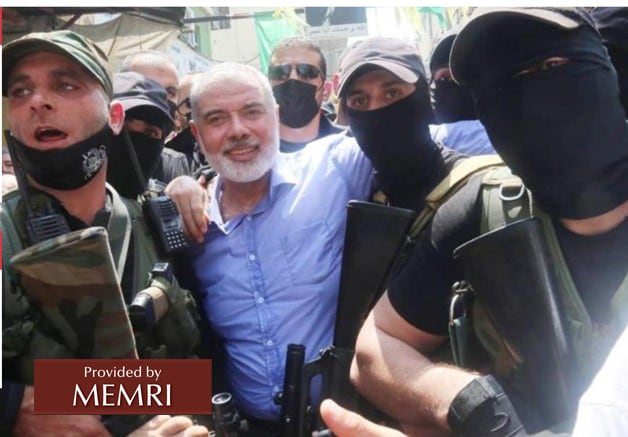 Haniya on a visit to the Ayn Al-Hilweh refugee camp in September 2020 (Image: Lebanonfiles.com, September 8, 2020)
Haniya on a visit to the Ayn Al-Hilweh refugee camp in September 2020 (Image: Lebanonfiles.com, September 8, 2020)
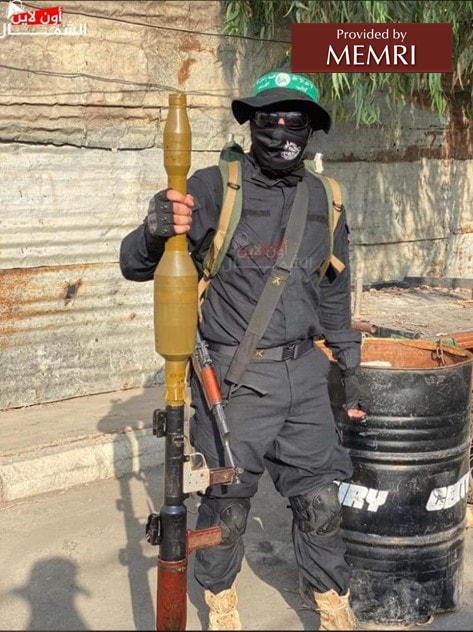 Al-Qassam Brigades operative at the Ayn Al-Hilweh refugee camp (Image: Army-tech.net, September 7, 2020)
Al-Qassam Brigades operative at the Ayn Al-Hilweh refugee camp (Image: Army-tech.net, September 7, 2020)
Suspicion That Hamas Is Establishing Military Industry In Lebanon
On December 10, 2021 an explosion shook the Burj Al-Shamali refugee camp in Lebanon. Hamas claimed it was caused by an electrical short circuit in a warehouse storing oxygen tanks for Covid-19 patients, but other sources in Lebanon claimed that it was caused when a fire that broke out in a mosque that housed a Hamas munitions warehouse. One man was killed in the blast: Hamza Shaheen, an engineer from a refugee camp in Jordan who had been arrested there for „supporting the resistance,” i.e., Hamas.[35]
Unclaimed Rocket Attacks From Lebanon
In addition to these indications of Hamas’ entrenchment in Lebanon, since 2014 there have been rocket attacks on Israel from Lebanon for which no organization took credit, but which were ascribed to Hamas. For example, on August 25, 2014, during the round of fighting between Israel and Hamas in Gaza, several rockets were fired from South Lebanon into northern Israel.[36] Half an hour later, Imad Zaqout, the news director for Hamas’ Al-Aqsa TV, claimed that they had been fired by elements „operated” by the Al-Qassam Brigades.[37] On May 13, 2021, also during a round of fighting in Gaza, three rockets were fired into Israel from Lebanon. This time a Palestinian source told the Lebanese Al-Nahar that „Palestinian factions” were responsible, and that the attack was meant to convey that „the resistance is one, in Lebanon and Palestine.” The daily reported that the Lebanese armed forces were looking for the launchers in the vicinity of the Al-Rashidieh refugee camp.[38] On July 19, 2021 two rockets were fired from Lebanon at Israel, presumably by Palestinian elements,[39] and on April 23, 2022 one rocket was fired. No organization claimed credit for launching it, but the IDF assessed that pro-Palestinian activists were responsible.[40]
On April 6, 2023, a barrage of 34 rockets was fired in an unclaimed attack, and Israel held Hamas responsible. According to reports in the Lebanese press, the attack came one day after a meeting in the Iranian embassy in Beirut between high-ranking figures in the resistance axis: Esmail Qaani, commander of the Iranian IRGC’s Qods Force, the leaders of Hizbullah, Hamas and the PIJ, and the heads of other militias backed by Iran. The reports claimed that the decision to launch the rockets had been taken at that meeting.[41]
Hamas Establishes Official Affiliate In Lebanon: 'The Vanguards Of the Al-Aqsa Flood’
In seems that Hamas has grown confident and seeks to expand the military activity waged by Palestinian factions against Israel from Lebanon, in flagrant violation of Lebanon’s sovereignty. On November 9, 2023, Hamas official Ali Baraka called on the Palestinian factions to establish military branches in Lebanon’s refugee camps. Speaking at a rally titled „Al-Aqsa Flood” [Hamas’ name for its October 7, 2023 attack on Israel] in the Burj Al-Shamali camp, Baraka said: „I’m not saying that [these] military branches must fight right now, but that they must prepare for the campaign of liberation and return to Palestine in a year or two. We must participate in the campaign of liberation along with the [factions] inside [Palestine] and the Islamic resistance in Lebanon [i.e., Hizbullah]… We in the [Lebanese] refugee camps must be part of the liberation, along with Hizbullah, the Syrians, the Iranians, the Iraqis and the Yemenis… We must prepare and train.”[42]
On December 4, 2023 Hamas announced the establishment of a new affiliate, the Vanguards of the Al-Aqsa Flood organization. Addressed to „the Palestinian people in Lebanon and the heroic jihad fighters,” the announcement stated that the organization was meant „to emphasize the role of the Palestinian people, wherever it is found, in resisting the occupation by all available and legitimate means, in order to complete what was achieved by Operation Al-Aqsa Flood.” The announcement called on Palestinian men and youth to join the organization and take part in „shaping the future of your people and liberating Jerusalem and the blessed Al-Aqsa Mosque.” Hamas’ representative in Lebanon, Ahmad Abd Al-Hadi, claimed that the new organization was not a military one, but other Hamas elements implied otherwise. Walid Al-Kilani, Hamas’ spokesman in Lebanon, said that the movement’s decision to recruit people to the new organization „does not mean that all of them will join the military action or the resistance action. Each [recruit will find] his [proper] place.” [43]
The PIJ, too, recently announced the establishment of a new force in Lebanon. It should be mentioned that, unlike Hamas, which for many years took pains to hide its military presence in Lebanon and started to declare it openly and claim responsibility for it only during the current war, the PIJ has long been open about operating against Israeli forces both in Lebanon and from Lebanon.[44] On October 6, 2023, one day before the October 7 attack, it announced the establishment of a new brigade in Lebanon named after Mahmoud Al-Majdoub, the commander of its military wing in the country, who was killed by Israel in Sidon in 2006.[45] The same day, a PIJ-affiliated Telegram channel posted photos showing members of the new brigade holding a ceremony in Beirut to mark the PIJ’s anniversary.[46]
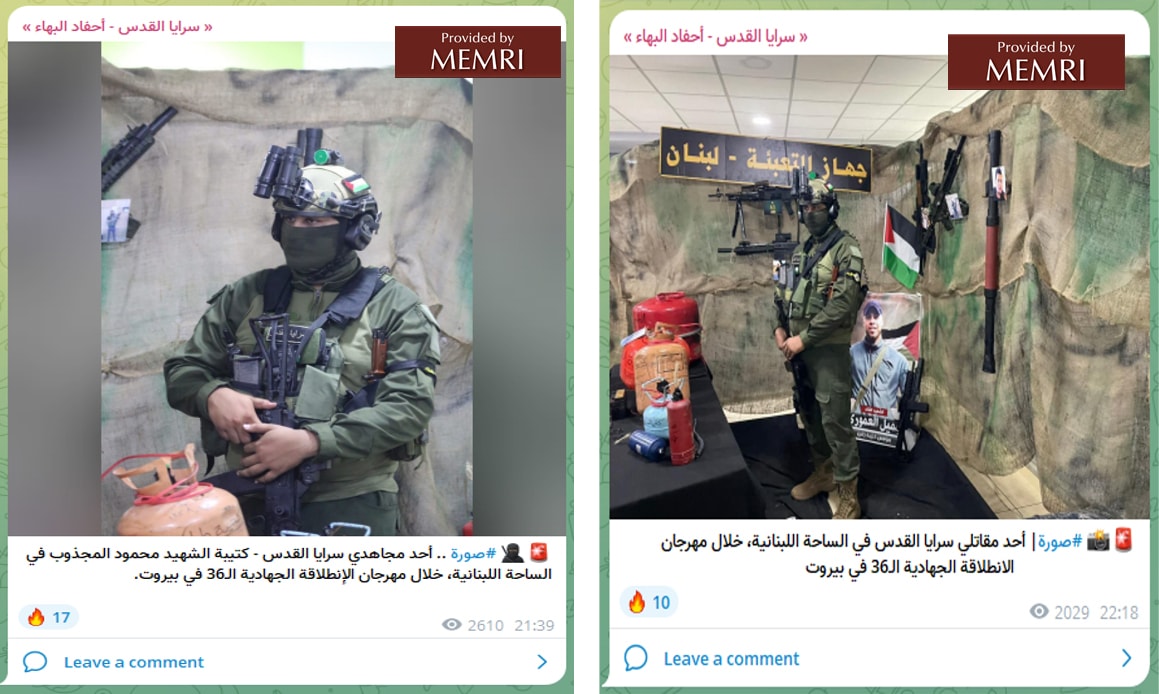 Fighters of the PIJ’s Mahmoud Al-Majdoub Brigade hold a ceremony in Beirut to mark the movement’s anniversary
Fighters of the PIJ’s Mahmoud Al-Majdoub Brigade hold a ceremony in Beirut to mark the movement’s anniversary
Criticism In Lebanon Of Palestinian Factions’ Activity From Lebanese Soil
The military activity of Hamas and the PIJ from Lebanese territory, and the presence of their senior commanders in the country, remind many in Lebanon of the time, during the 1970s and 1980s, when Palestinian factions headed by Fatah were active there, with devastating consequences for Lebanon. Lebanese politicians and journalists, especially those identified with the camp opposed to the resistance axis, expressed concern about the possible recurrence of these events and pointed out that the Palestinian activity is taking place with Hizbullah’s knowledge and consent. Criticism was also leveled at the government, which is doing nothing to stop this activity despite the danger of a harsh Israeli response against Lebanon.
About a month after the start of the war in Gaza, Alan Sarkis, a columnist for the Nidaa Al-Watan daily, addressed the attacks launched against Israel from South Lebanon by various Lebanese and Palestinian factions, and warned: „South Lebanon has once again become a lawless war zone, and the Lebanese people’s dream of a proper state has evaporated… The south is on the brink of a volcano and nobody knows when it will erupt…” Sarkis wondered: „Where do these fighters come from? Why don’t the state and the [security] apparatuses apprehend them, especially given that they control the entrances and exists of the [Palestinian] refugee camps? We are not talking about the smuggling of furniture, fuel or flour. Some people are taking rocket launchers and firing them without the knowledge of the legitimate authorities, [while disregarding] the harm that may be caused to Lebanon by the enemy…”[47]
Hamas’ announcement about the establishment of its new affiliate in Lebanon, the Vanguards of the Al-Aqsa Flood organization, was regarded by these circles as a provocation and an act of defiance against the state’s authority and sovereignty. They called on the state to enforce its control of South Lebanon and deploy the armed forces along the Israeli border.[48]
The criticism intensified following the January 2, 2024 killing, attributed to Israel, of Saleh Al-Arouri, the deputy head of Hamas’ political bureau, in the Dahya in southern Beirut. Lebanon’s former prime minister Fouad Al-Siniora wondered: „Is it proper for this number of armed organizations, Palestinian and other, to be [present] in many parts of Lebanon, including in Beirut’s southern Dahya?…”[49]
Journalist May Chidiac, who is known for her criticism of Hizbullah and even survived an assassination attempt, wrote on her X account: „The Lebanese state wants to file a complaint with the UN in protest against the enemy’s [attacks] on its soil! Perhaps it is right, but how will it explain [the fact] that Hamas officials hold meetings on Lebanese soil to plan their operations, and hold press conferences in which they threaten Israel from Lebanon and put the security of the Lebanese people in danger in the name of [the principle of] the 'unity of the fronts’?! Enough! We don’t need to pay the price of anyone else’s [war].”[50]
Some even demanded to expel Hamas from the country for endangering the lives of the Lebanese. Political activist Racha Itani wrote on X: „After the airstrike on the Dahya today, we demand to expel all the commanders of Hamas and the jihadist movements from Lebanon in order to protect the Lebanese people.”[51]
Media figure and actress Carine Salameh wrote: „Attack me as much as you want. The Lebanese people does not want to continue paying the price of anyone else’s war. Leave us alone, let us be. You have been killing us since 1975… Shame on you…”[52]
Criticism was also directed at the Lebanese authorities, for allowing the presence and activity of the Palestinian factions on Lebanese soil. Former MP Fares Sou’aid wrote on X: „(1) The Lebanese government is aware of the danger posed by the presence in Lebanon of a commander of the caliber of Saleh Al-Arouri, [but] it was lenient in handling this matter; (2) The feebleness of the government places Lebanon, all of Lebanon, [in danger]. Today it was the southern Dahya, and tomorrow it will be Jounieh, Tripoli and Al-Beqaa…”[53]
Following Hamas’ launching of 40 rockets at Israel on February 28, Rosana Bou Monsef, a columnist for the Al-Nahar daily, wrote that Hamas and the other Palestinian factions are operating in South Lebanon in coordination with Hizbullah, and slammed the Lebanese government for doing nothing to stop this. In her article, titled „The Al-Qassam Rockets in South Lebanon Are Cause for Concern, Yet There Is No Response,” she noted that „the Lebanese armed forces have never arrested any Palestinian or other element for firing rockets at Israel from South Lebanon, even though [UN] Resolution 1701 obligates them to do so…” One of the consequences of this, she added, is „the postponement or cancellation” of a conference that was supposed to be held in France and Italy regarding the provision of aid to the Lebanese armed forces. She called on Hamas to act responsibly and not disregard the consequences of its actions for Lebanon, just as Hamas itself expects the international organizations to discharge their duty regarding the events in Gaza. Urging the government to represent all the Lebanese, „not just one sector, which grants the Palestinian organizations freedom to launch rockets from the south,” she wondered: „Does Lebanon benefit from the escalation of the Palestinian [activity] in the south[?] Is it is aware of the possibility of war with Israel if the Al-Qassam [Brigade’s] rockets hit Israel and prompt a harsh military response against Lebanon?… [The government] is behaving as though what is happening in the south does not interest it, although it will be the one to bear full responsibility during and after the war, if it breaks out.”[54]
*N. Mozes is a research fellow at MEMRI; Y. Yehoshua is MEMRI Vice President for Research.
[1] The Forces of Dawn (Quwat Al-Fajr) militia, affiliated with the Sunni Lebanese Jama’a Al-Islamiya organization, has claimed responsibility for firing rockets into Israel (Al-Nahar, Lebanon, October 20, 2023; Telegram.me/farok80, October 29, 2023). The Shi’ite Amal movement has reportedly carried out attacks as well, and announced that several of its operatives have been killed in South Lebanon. See MEMRI JTTM reports: Lebanese Daily: Hundreds Of Hizbullah-Allied Amal Movement Operatives Deployed On Lebanon-Israel Border, Carrying Out Attacks On Israel, November 14, 2023; Hizbullah-Allied Amal Movement Announces 'Martyrs’ In Israeli Strikes In Southern Lebanon, February 15, 2024.
[2] Telegram.me/Hamas Movement, October 10, 2023.
[3] Telegram.me/qassambrigades, October 15, 2023.
[4] Telegram.me/qassambrigades, October 19, 2023.
[5] Telegram.me/qassambrigades, October 29, 2023.
[6] Telegram.me/qassambrigades, November 2, 2023.
[7] Telegram.me/qassambrigades, November 6, 2023.
[8] Telegram.me/qassambrigades, November 12, 2023.
[9] Arabic.rt.com, December 10, 2023.
[10] Telegram.me/qassambrigades, December 25, 2023.
[11] Telegram.me/qassambrigades, January 17, 2024.
[12] Telegram.me/qassambrigades, February 28, 2024.
[13] Telegram.me/hamasps, October 15, 2023.
[14] Telegram.me/Hamas official, November 22, 2023.
[15] See MEMRI JTTM Report, Two Operatives With Turkish Citizenship Have Been Killed In Southern Lebanon, Including The Son Of A Mujahid Who Fought In Afghanistan And Chechnya, November 22, 2023.
[16] Al-jazeera.net, January 3, 2024.
[17] Telegram.me/qassambrigades, January 3, 2024.
[18] Telegram.me/qassambrigades, January 18, 2024.
[19] Telegram.me/jihad_press, October 10, 2023.
[20] Telegram.me/sarayaps, October 22, 2023.
[21] Telegram.me/sarayaps, October 29, 2023.
[22] Telegram.me/sarayaps. December 12, 2023.
[23] Telegram.me/sarayaps, December 29, 2023.
[24] Telegram.me/sarayaps, February 12, 2024.
[25] Telegram.me/sarayaps, February 24, 2024.
[26] Telegram.me/ansarollah1, October 30, 2023.
[27] Al-Nahar (Lebanon), February 7, 2024.
[28] Al-Quds Al-Arabi (London), October 30, 2023.
[29] See MEMRI Special Dispatch No. 10944, Arab Daily: Hamas, Palestinian Islamic Jihad Are Asking Hizbullah To Give Them Greater Freedom To Operate Against Israel From South Lebanon, November 7, 2023.
[30] Wattan.net, February 5, 2015.
[31] See MEMRI Special Dispatch No. 7450 – Following The Murder In Malaysia Of Palestinian Engineer Fadi Al-Batsh, Hamas Supporters Debate Whether To Act Against Israel Abroad – May 1, 2018.
[32] See e.g., MEMRI Special Dispatch No. 10100 – Hamas Political Bureau Head Isma’il Haniya’s Visit To Lebanon Sparks Criticism In Country: He Is Embroiling Lebanon In Regional Conflicts In Service Of Iran – July 27, 2022.
[33] Al-Jazeera.net, September 15, 2023. It should be noted that Hamas has been careful not to take part in the armed clashes between various Palestinian factions that periodically break out in the camps (Almodon.com, October 19, 2023). Moreover, at least in the clashes that broke out in the Ayn Al-Hilweh camp in 2023, it took care to position itself as a mediator between Fatah and the Islamist factions, in an attempt to increase its influence in the camp. This is despite the fact that, according to some, Hamas was the one that incited these Islamist factions to clash with Fatah in the first place, in order to weaken it and perhaps also in order to blacken its public image (Al-Nahar, Lebanon, September 13, 2023; janoubia.com, July 31, 2023).
[34] Army-tech.net, September 7, 2020.
[35] Almodon.com, October 19, 2023. Special Dispatch No. 9689 – Following Explosion Of Hamas Arms Depot In South Lebanon Mosque, Lebanese Politicians, Journalists Call To Remove Palestinian Weapons From Country – December 21, 2021.
[36] Ynet.co.il, August 25, 2024.
[37] See MEMRI Special Dispatch No. 5966 – Hamas Al-Aqsa TV News Chief: Rockets From Lebanon In Recent Gaza War Were Fired On Instructions By Hamas Military Wing – February 17, 2025.
[38] Al-Nahar (Lebanon), May 13, 2021.
[39] Ynet.co.il, July 20, 2021.
[40] Ynet.co.il, April 25, 2022.
[41] See MEMRI Special Dispatch No. 10562 – Lebanese Media Reports: On The Evening Before The April 6, 2023 Rocket Attack On Israel, Iranian Qods Force Commander Esmail Qaani Visited Lebanon, Met With Officials From Hizbullah, Hamas, Palestinian Islamic Jihad – April 13, 2023.
[42] Elnashra.com, November 13, 2023.
[43] See MEMRI Inquiry & Analysis No. 1732, „Public Uproar In Lebanon Following Hamas-Lebanon’s Announcement Of New Resistance Organization: We Don’t Want 'Hamas-Land’ In Lebanon,” December 12, 2023.
[44] On May 28, 2022, the PIJ’s Lebanon branch issued a video reviewing the attacks carried out over the years by the organization’s military wing in Lebanon under the command of Mahmoud Muhammad Al-Majdoub. Most of the attacks were on the IDF forces in Lebanon (during the time they were present in the south of the country), apart from two attacks inside Israel carried out by PIJ operatives from Lebanon: one in Misgav Am in October 1993 and the other in Shlomi in March 2002. The video shows a group of PIJ operatives in a room looking at maps and operation plans. Towards the end of the video, a figure wearing a ring characteristic of senior Shi’ite leaders appears and is saluted by the operatives, which reflects the PIJ’s deference to Iran and Hizbullah (Telegram.me/ma7warbrigades, May 28, 2022). According to the organization’s statements, Syria and Lebanon are not the only arenas of its military activity abroad. In 2003 it announced that its first „self-sacrificing fighters” (fida’iyoun) had arrived in Baghdad to fight the American and British invasion. The PIJ’s representative in Lebanon, Abu Imad Al-Rifa’i, clarified that these fighters were Palestinians from the diaspora, from several countries. He did not disclose their number, saying only that „many” of them would arrive in Iraq. He stressed that fighting the American occupation in Iraq was part of defending the Palestinian people (Aljazeera.net, March 30, 2003).
[45] Samanews.ps, October 6, 2023.
[46] Telegram.me/ahfadalbahaa, October 6, 2023.
[47] Nidaa Al-Watan (Leanon), November 9, 2023.
[48] See MEMRI Inquiry & Analysis No. 1732 – Public Uproar In Lebanon Following Hamas-Lebanon’s Announcement Of New Resistance Organization: We Don’t Want 'Hamas-Land’ In Lebanon – December 12, 2023.
[49] Al-Sharq Al-Awsat (London), January 4, 2024.
[50] Twitter.com/may_chidiac, January 2, 2024.
[51] Twitter.com/RachaItani, January 2, 2024.
[52] Twitter.com/SalamehCarine, January 2, 2024.
[53] Twitter.com/FaresSouaid, January 3, 2024.
[54] Al-Nahar (Lebanon), March 1, 2024.
Visit the MEMRI site in Polish: http://www2.memri.org/polish/
If you wish to reply, please send your email to memri@memrieurope.org.






